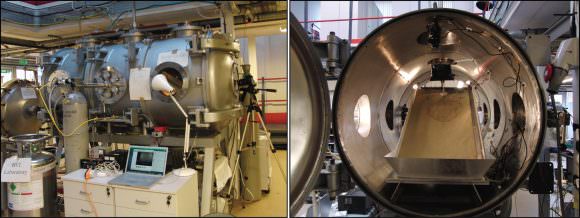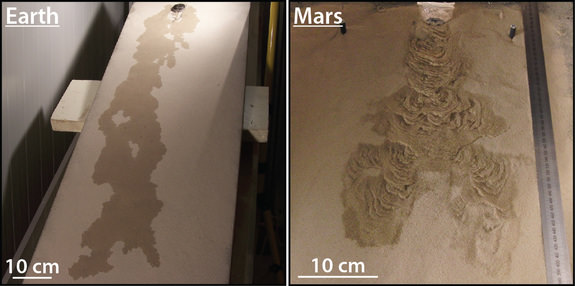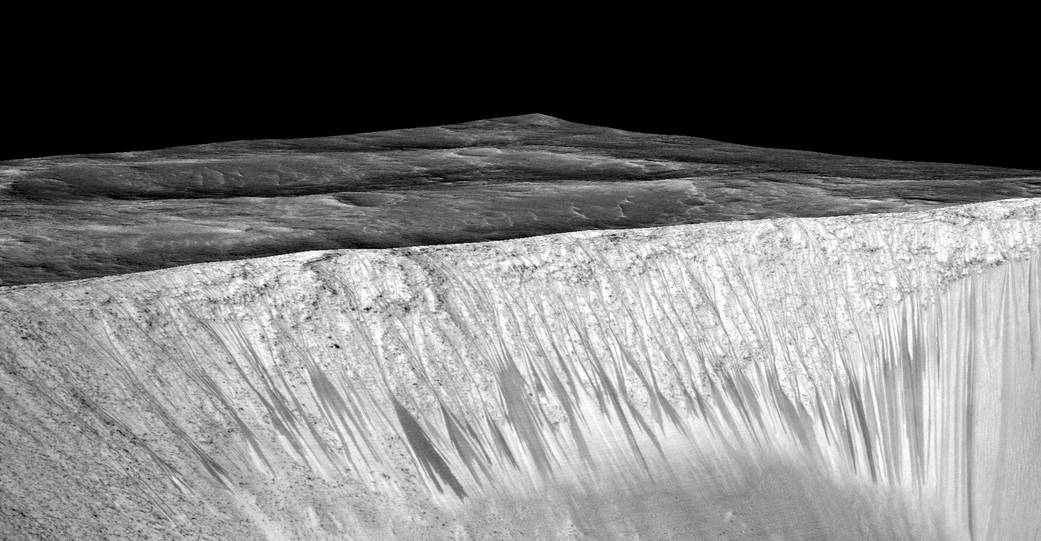Finding water on Mars is a primary focus of human efforts to understand the Red Planet. The presence of liquid water on Mars supports the theory that life existed there. Now it looks as though some puzzling features on the surface of Mars could have been caused by boiling water.
Recurring slope lineae (RSL) are dark streaks found on slopes on the surface of Mars. It was thought that these streaks could have been caused by seasonal melting. Other proposed causes were dust avalanches or the venting of carbon dioxide gas. Since the same features are also found on the Moon, they could also be caused by tiny meteorites that cause avalanches. But now a study from researchers at the Open University of England shows that boiling water could have created the patterns.
We don’t have to go looking for thermal vents to find the source of this boiling water. The atmospheric pressure on Mars is so low that any liquid water would boil, without the need for a heat source. At about 1/100th the atmospheric pressure of Earth, Martian water will boil easily.
You don’t have to travel to Mars, or build an atmospheric pressure simulator, to observe the fact that water boils more readily under lower atmospheric pressure. You can see it happen here on Earth. As hikers and mountaineers know from experience, water boils more quickly the higher you go in the mountains. The greater your altitude, the less atmosphere there is pushing down on you, which lowers the boiling point of water. On Mars, that effect is extreme.
The team of researchers, led by M. Masse, performed their experiments in a chamber that can recreate the atmospheric pressure on Mars. Inside the chamber, they built a slope of loose, fine-grained material, and placed a block of ice on it. At first, the team kept the pressure inside the chamber identical to Earth’s atmospheric pressure, and the melting ice had little effect on the slope of loose material.

But when they reduced the atmosphere inside the chamber to that of Mars, the water boiled quickly, creating a much more pronounced effect. This vigorous boiling action caused sand grains to fly into the air, creating heaps. As these heaps collapsed, avalanches were triggered. The end result was the same kind of flow patterns observed on Mars.
Numerous other studies have found evidence of liquid water on Mars, and features like the RSL appear to have been caused by water. But though this study seems to add to that growing evidence, it also puts the brakes on the idea that liquid water is present on Mars.
For these RSL to occur on Earth requires a certain amount of water. But because of the ‘boiling water effect’ of the lower pressure atmosphere on Mars, much less water is required to create them. Not only that, but the fact that water boils away so quickly means that any liquid water is short-lived, and would not provide an adequate environment for micro-organisms.

Also, the effect that Mars’ lower gravity has on the formation of RSLs is not well understood, and may be another part of the equation. The researchers’ ‘Martian Chamber’ was not built to mimic Mars’ gravity.
These are interesting preliminary results, flawed only by the lack of simulated Martian gravity. For these results to be conclusive, the same process would have to be observed on Mars itself. And that’s not happening anytime soon.


“The presence of liquid water on Mars supports the theory that life existed there.” Based on what criteria? The intrinsic complexity in diversity of biologic systems information theory preclude such trivial generalizations of conditions for life forming. Get serious. The present failed theory of life progression, aka neo-Darwinism, does not even attempt to propose a comprehensive, plausible theory of abiogenesis. The reason is life cannot come from non-life, and chemical evolution is a myth. Unless God decided to start a new earth-like scenario on Mars and let it go extinct, the only life they will ever find on MARS or any exoplanets is life that is delivered there from earth, intentionally, or unintentionally.
which god is that?
The uncaused cause that created time, space, matter and energy, not to mention all metaphysical reality and organic life, the only viable physical life form.
Ooh.. so you mean MY God then.. Bob. Yes, he’s awesome like that. He loves creating life all over the universe.
Ooh.. so you mean MY God then.. Bob. Yes, he’s awesome like that. He loves creating life all over the universe.
See headline. It’s obvious that this “technical writer” does not understand technical writing, or forcefully ignores his training. More like an entertainment weekly writer.
I’ll hold out for finding life on Mars in underground liquid aquifers somewhere in the Hellas Planetia impact basin..
Headline: ‘boiling water IS causing” Paragraph 1: ‘COULD have been caused by boiling water.” Come on guys, is this dailymail.co.uk? haha
Recurring Slope Lineae (RSL) have been found along crater rims in several equatorial locations. This bodes well for the eventual discovery of RSL source aquifers near the surface.
Is it possible that some percentage of the early seas may have been lost due to being buried or covered over and entombed by volcanic ash and forced into a subterranean retreat?
Your conjecture is justified as there has been a lot of time and a lot of complex geology going on. Testing every plausible scenario would appear to be the biggest challenge.